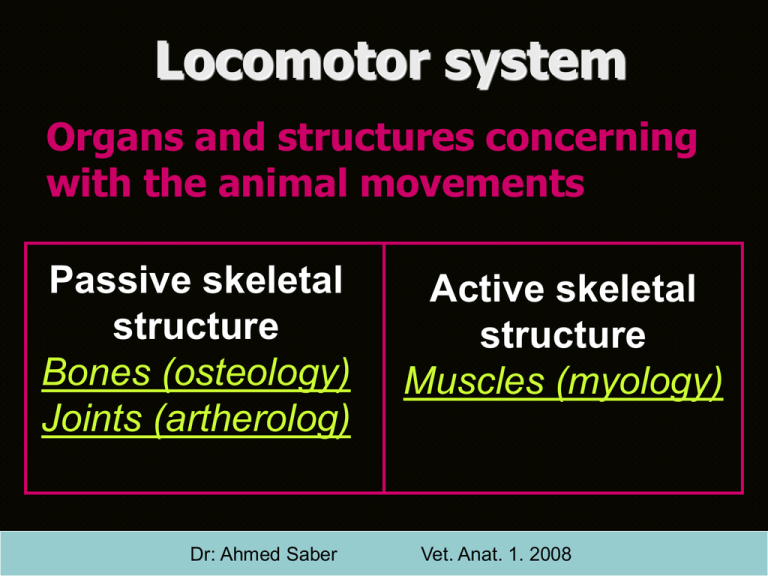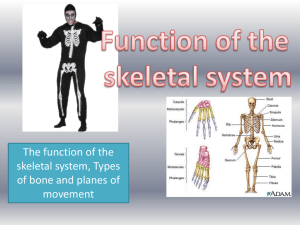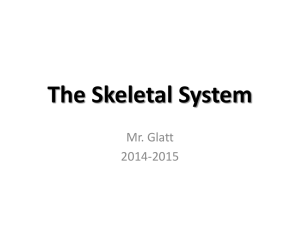
Locomotor system
Organs and structures concerning
with the animal movements
Passive skeletal
structure
Bones (osteology)
Joints (artherolog)
Dr: Ahmed Saber
Active skeletal
structure
Muscles (myology)
Vet. Anat. 1. 2008
Osteology
Def: it is the science deals with the
bones
Functions of bones
1.
2.
3.
4.
5.
6.
give the body shape (through skeleton)
Storage of minerals (calcium)
Storage of lipids (yellow marrow)
Blood cell production (red marrow)
Protection
Leverage (force of motion)
Dr: Ahmed Saber
Vet. Anat. 1. 2008
Classification of bones
I- according to shape, position and function
1-long or tubular bones
•Long, cylindrical with central
cavity
•have long body, proximal and
distal extremities
•Present in limbs as humerus,
radius and femur
•Act as supporting column and
levers
Dr: Ahmed Saber
Vet. Anat. 1. 2008
1-long or tubular
bones (cont)
Reduced long bone:
have very small
central cavity as small
metatarsal and
metacarpal bone
elongated bone: have
no medullary cavity as
ribs
Rib
Dr: Ahmed Saber
Vet. Anat. 1. 2008
2- flat bones
Is plate like
give area for muscles
attachments
Protect underline vital
organ
Scapula, pelvic bone and
skull
3- short bones
Has similar dimensions
diffuse and reduce
concussion
carpal and tarsal bone
Dr: Ahmed Saber
Carpal bones
Vet. Anat. 1. 2008
4- Irregular bones
irregular in shape
single bone & median
position
As vertebrae
vertebra
5- sesamoid bones
Present between tendons
and joint
reduce the frictions
between tendons and
bones
As proximal and distal
sesamoid bones
Dr: Ahmed Saber
Vet. Anat. 1. 2008
6- pneumatic bone
Have air spaces instead of central
cavity
As Para-nasal sinus of mammal
the majority of birds skeleton
Dr: Ahmed Saber
Vet. Anat. 1. 2008
II- according to their structures
1- compact bone
Forming the external dense shell of all bones
Its thickness is differ
– thick in the middle and thin at the extremities
Medullary cavity
Compact bone
Periosteum
Dr: Ahmed Saber
Vet. Anat. 1. 2008
Haversian system or osteon: is the
microscopical structure of bones
Dr: Ahmed Saber
Vet. Anat. 1. 2008
2- Spongy bones
Delicates bony spicules
and trabeculae
have spongy
appearance
Its spaces is filled by
bone marrow
The spongy bone
(trajectories) fill the
short bones
And fill the extremities
of long bones
Dr: Ahmed Saber
Compact
bone
Spongy bone
Marrow
space
Bony trabeculae
Vet. Anat. 1. 2008
III- according to their development
1- endochondral bones:
from hyaline cartilage
All except skull and flat bone
2- intramembranous bones:
From fibrous membranes
Cranial and flat bones
Dr: Ahmed Saber
Vet. Anat. 1. 2008
IV- according to their position
1- Axial bones: unpaired, in medain line
Skull, vertebrae, sternum
2- Appendicular bones:
bone of limbs
3- Splanchnic or visceral bones: within
soft tissues os cordis of ruminant, os penis
of dog, os diaphragmatic of camel
Dr: Ahmed Saber
Vet. Anat. 1. 2008
Cross anatomical
components of long bone
Periosteum
Endosteum
Dr: Ahmed Saber
Compact bone
Medullary cavity
Vet. Anat. 1. 2008
1-Periosteum
(the outer connective tissue
covering), it divided into
– Outer protective layer (more
fibers)
– Inner cellular layer
(osteogenic )
Its function
– Isolate bone from
surrounding tissues
– route for circulatory and
nervous supply
– bone growth and repair
Dr: Ahmed Saber
Inner cellular
layer
Outer fibrous
layer
Vet. Anat. 1. 2008
2- Compact substance
Thick at the shaft and thin at extremities
3- Spongy bone
at the extremities
4- Medullary cavity
contain the marrow
5- Bone marrow
in the central cavity of long bones and within
the spaces of spongy bone
Dr: Ahmed Saber
Vet. Anat. 1. 2008
types of bone marrow
– Red marrow (mainly in young and rich in blood
forming cells)
– Yellow marrow( in adult, much amount of fat
cells)
– Gelatinous (degenerated yellow marrow in
senile animal or badly nourished animal)
6- Endosteum
– thin fibrous membrane
– lined the central cavity and haversian canals of
long bone.
– covers the trabeculae of spongy bones
Dr: Ahmed Saber
Vet. Anat. 1. 2008
Gross anatomical regions of
long bone
1.Middle body (shaft or diaphysis)
2.Proximal and distal extremities (epiphysis)
3.In young the growth zone (metaphysis) is
located between epiphysis and diaphysis)
4. in adult metaphysis become ossify know
as epiphyseal line
Dr: Ahmed Saber
Vet. Anat. 1. 2008
Articular cartilage
Spongy bone
Epiphysis
Epiphyseal line or
metaphysis in young
Periosteum
Compact bone
Diaphysis
Endosteum
Medullary cavity
Epiphyseal line or
metaphysis in young
Epiphysis
Dr: Ahmed Saber
Vet. Anat. 1. 2008
Gross structures of short,
irregular and flat bones
Periosteum
Compact layer
Spongy bone
(trabeculae, spaces,
endosteum and marrow
Compact layer
Periosteum
In the skull the spongy bones is called diploe,
contain diploic veins
Dr: Ahmed Saber
Vet. Anat. 1. 2008
Chemical composition of bones
The bones are hard structures consists of 5% water
and 95% solid materials, that divided into
A-organic material (35%)
cells, osteoid (ground sulfated
mucopolysaccharides) and collagen
fibers
it provides toughness and elasticity
B- inorganic materials (65%)
mostly calcium and phosphorus
it provides hardness to bones
Dr: Ahmed Saber
Vet. Anat. 1. 2008
Blood and nerve supply of
bones
1- Arterial blood
supply
I.
II.
III.
IV.
medullary or
nutrient artery
periosteal arteries
epiphseal arteries
metaphyseal
arteries
Dr: Ahmed Saber
Vet. Anat. 1. 2008
2- Venous drainage
few
accompany arteries
but the majoirty not accompany the arteries,
they emerge near the articular surfaces
3- Lymph vessels
forming
channels within periosteum and
haversian canals
larger lymphatic passes with the veins
4- Nerve supply
vasomotor
(autonomic) to vessels
sensory fibers distributed mainly in the
periosteum
Dr: Ahmed Saber
Vet. Anat. 1. 2008
Skeleton
It is the framework of hard structures (bones &
cartilages) which support the soft tissues, and is
divided into
1- Exoskeleton
from ectoderm
shells, scales of fish, feather of birds, hair
and hoofs of mammals
2- Endoskeleton
from mesoderm (except notochord from
endoderm)
bones and cartilages of animal
Dr: Ahmed Saber
Vet. Anat. 1. 2008
Classification of
mammalian skeleton
1- Axial skeleton
skull, vertebrae, ribs
and sternum
2- Appendicular
skeleton
bones of limbs
3- Splanchnic or
visceral skeleton
os penis of dog, os
cordis of ruminant, os
diaphragmaticus of
camel
Dr: Ahmed Saber
Vet. Anat. 1. 2008










